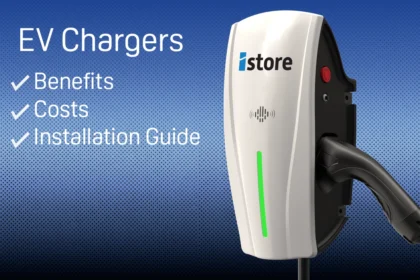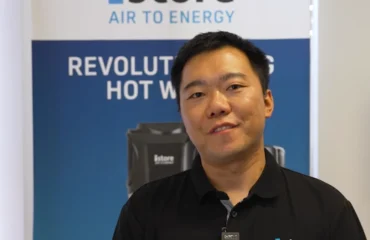
You’ve already cut your carbon footprint by switching to an electric vehicle, but why stop there? Power your EV with sunshine to take clean driving to the next level!
If you have solar panels (or plan to), a solar EV charger lets you skip the grid and charge straight from your roof. It’s clean, convenient, and seriously satisfying!
In this guide, you’ll find out how solar-powered EV chargers work, why they’re a smart move, how much they cost, and what’s involved in installing one.
How Does a Solar EV Charger Work?
A solar EV charger uses power generated by rooftop solar panels to charge your electric vehicle.
When the sun hits your panels, a solar inverter converts the sunlight into usable electricity. This electricity flows through your switchboard to the EV charger, delivering power to your vehicle’s battery to charge it.
If your solar system includes a solar battery, any energy generated during the day that your home doesn’t use can be stored to charge your EV later when the sun isn’t shining, like at night or during cloudy weather. Using stored solar power helps you get the most out of your system and reduce reliance on grid electricity, keeping charging costs down.
Smart EV chargers take solar charging a step further. They track when your solar system produces the most energy and automatically adjust charging times for maximum efficiency. Some models connect to an app, so you can monitor charging, set schedules, and optimise energy use from your phone.
Benefits of Solar EV Chargers
- Cost Savings: Use free solar energy to charge your EV and reduce reliance on expensive grid electricity, especially during peak hours when demand and rates are highest.
- Sustainability: Lower your carbon footprint by powering your vehicle with renewable energy from the sun instead of electricity generated from fossil fuels like coal or gas.
- Convenience: Charge at home during the day or night without queuing at public charging stations.
- Government Incentives: Federal and state-based incentives for installing solar batteries aim to make solar EV charging more accessible and affordable for Australians.
- Federal Cheaper Home Batteries Program: Starting July 1, 2025, this program offers up to a 30% reduction in the cost of home batteries, potentially saving households up to $4,000.
- State-Based Rebates: Various states provide additional incentives. For example, New South Wales offers up to $2,400 off the installation cost of a solar battery for homes and businesses with existing solar.
Technical Requirements
Before installing a solar EV charger, you must make sure it’s technically compatible with your EV, solar system, and home electrical infrastructure.
Consider
- Your EV and Solar System Specs: Review your EV’s charging capabilities and your solar system’s output. Confirm that your panels generate enough electricity to support regular charging based on your driving habits.
- Wattage and Voltage Compatibility: Your EV charger should match the voltage of your home’s electrical system and the capacity of your solar setup. Most home EV chargers in Australia operate on single-phase (up to 7.2 kW) or three-phase power (up to 22 kW).
- Solar Panel Efficiency: Not all solar panels perform the same. High-efficiency panels convert more sunlight into electricity, producing plenty of power even if you have limited roof space for panels.
- Battery Storage: Adding a solar battery lets you store excess solar energy for later use, which is ideal for overnight EV charging or when solar generation is low.
- Your Charger’s Charging Modes: EV chargers have different charging modes (Level 1, 2, and 3). Level 2 is the most common for home solar setups and is suitable for daily use. It provides faster, safer, and more efficient charging than a standard household power point (Level 1).
Choosing the Right Solar EV Charger for Your Home
Once you’ve covered the technical basics, choose a solar-powered EV charger that fits your lifestyle, budget, and future plans.
Look for
- Smart, High-Quality Features: Smart chargers with app connectivity let you schedule charging, monitor energy use, and prioritise solar power over grid electricity. iStore EV chargers feature user-friendly monitoring, built-in safety protections, and high energy efficiency.
- Solar Compatibility Settings: Some chargers are built specifically for solar use, with features like solar-only charging or dynamic load balancing. These features help maximise your available solar energy without drawing from the grid.
- Installation Suitability: Consider cable length, mounting options, and whether a pedestal or wall mount suits your space better.
- Scalability: Planning to upgrade your solar system, battery, or even get another EV down the track? Choose a charger that supports load sharing or future upgrades so you won’t need to replace it later.
- Brand Reliability and Support: A reputable brand should offer solid customer support, warranty coverage, and local technical service for peace of mind.
Costs and Installation of Solar EV Chargers
Charger type, brand, and installation complexity influence the overall cost of installing an EV solar charger.
The price for a Level 2 charger can range from $1,000 to $2,500. Basic installation can cost between $500 and $1,000, while complex installation requiring a switchboard upgrade or longer cable run can cost $1,000 to $3,000.
What if you’re starting from scratch and don’t have a solar system yet?
For a typical 5-6 kW residential solar system, solar panels can range from $5,000 to $9,000. A bigger 10kW system can cost between $7,500 and $10,500.
An optional 5 kWh solar battery can cost $9,800, and a 15 kWh battery can be up to $18,500.
Now that you have an idea about prices, let’s look at what the installation process involves.
- Site Assessment: A licensed electrician will evaluate your home’s electrical system, solar setup, and EV charging needs.
- Installation: They’ll mount the solar EV charger, connect it to your home’s electrical system, and link it with your solar inverter and battery if applicable. They may also install safety switches or upgrade components like the switchboard to meet Australian safety standards.
- Testing and Commissioning: After setup, the installer will test the charger’s performance, check for any electrical faults, and confirm that the system charges your EV safely. They’ll also walk you through how to use it.
Solar Panel Considerations
Your solar panel setup needs to be up to the task of charging your EV.
Keep in mind
- System Size: A solar system of 6.6 kW or more is recommended to generate enough power for household use and EV charging.
- Inverter Capacity: Your solar inverter must handle the combined load of your household and EV charging needs.
- Roof Space: More panels mean more energy, but you’ll need the roof space to match. High-efficiency panels can help if space is limited.
- Panel Orientation: North-facing panels will maximise solar generation throughout the day.
- Daytime Charging Habits: Solar energy is most available during daylight hours. Charging your EV during the day will let you use more solar power, especially if you don’t have a battery.
- Future Expansion: If you plan to add another EV or a home battery later, consider oversizing your solar system to avoid costly upgrades later.
Battery Life and Performance
When managed correctly, solar charging is generally gentle on EV batteries.
Unlike fast public chargers that deliver high-power bursts, home solar chargers provide a slower, steadier charge. This charging speed reduces heat and stress on the battery, preserving its lifespan.
Charging during the day directly from solar generation, or overnight using stored battery energy, allows for a more controlled charge-discharge cycle. Avoiding frequent full charges and letting the battery drain fully also contributes to longer battery life.
Many EVs and smart chargers have apps that track charging habits, battery temperature, and state of charge. Using these tools helps you monitor performance, adjust your charging times, and maintain your battery’s long-term efficiency.
FAQs
Can I Charge My EV Directly With Solar Panels?
Yes, but you’ll need a compatible inverter and EV charger to convert and manage the solar energy for vehicle charging.
How Much Does It Cost To Install a Solar EV Charger?
A Level 2 solar-powered EV charger can range from $1,000 to $2,500.
Basic installation can cost between $500 and $1,000, while complex installation requiring a switchboard upgrade can cost $1,000 to $3,000.
Do I Need a Battery for My Solar EV Charger?
A battery isn’t required for an EV solar charger, but it helps. Without one, you can only charge during daylight hours. A battery lets you store excess solar energy for nighttime or cloudy-day charging.
How Long Does It Take To Charge an EV With Solar Energy?
Charging time depends on solar system size, charger type, and EV battery capacity. With a typical 7 kW home charger and good solar conditions, a full charge can take 6–10 hours.
Drive Into the Future With an iStore Solar EV Charger
Why pay for power when the sun gives it away for free?
An EV solar charger charges your EV using free, renewable energy from your rooftop. It’s sustainable and eco-friendly, and will save you cash!
Explore iStore’s solar EV chargers today to drive smarter. Then, get in touch for expert advice or a quote by calling 1300 515 640 or filling out this online form.




